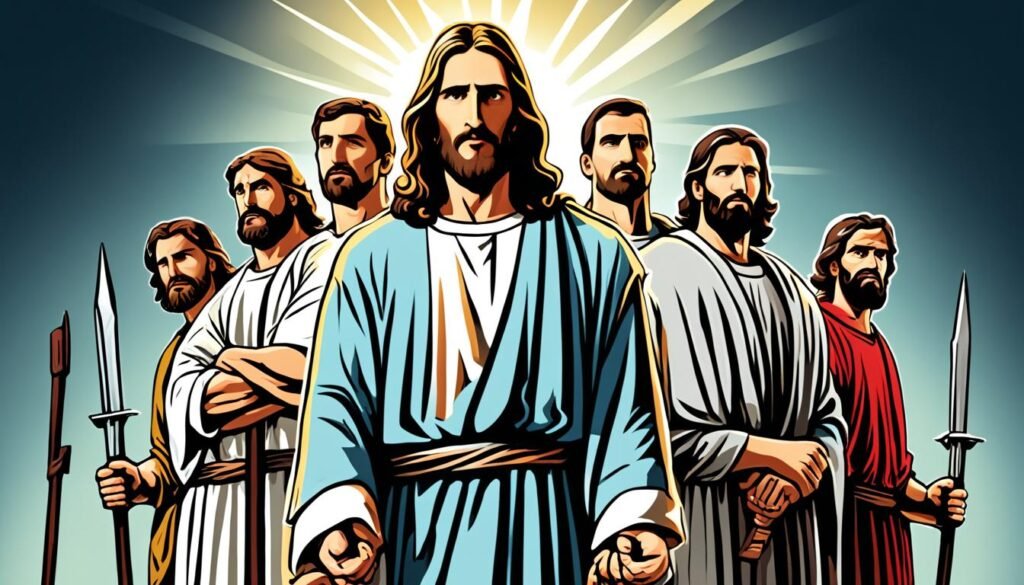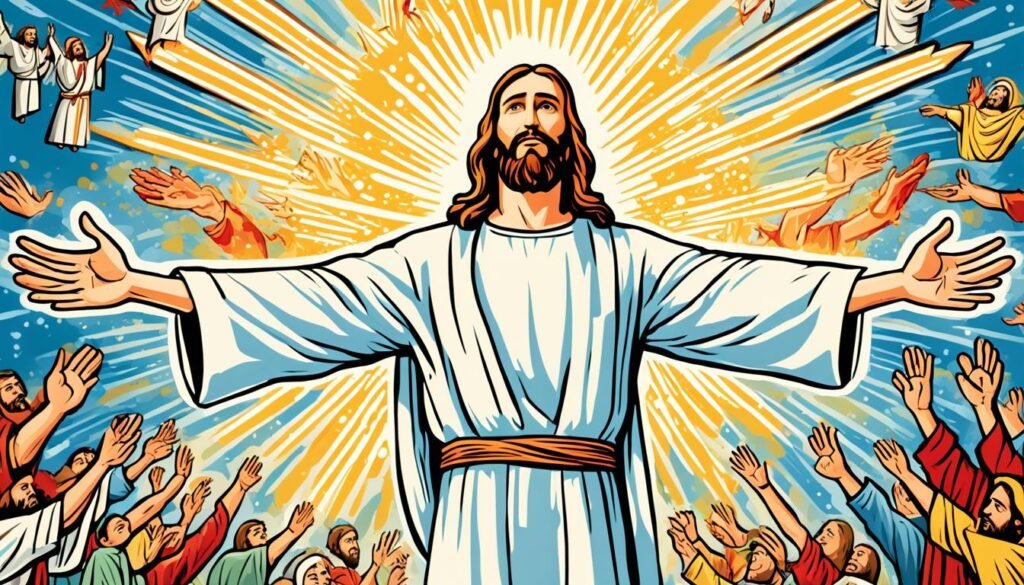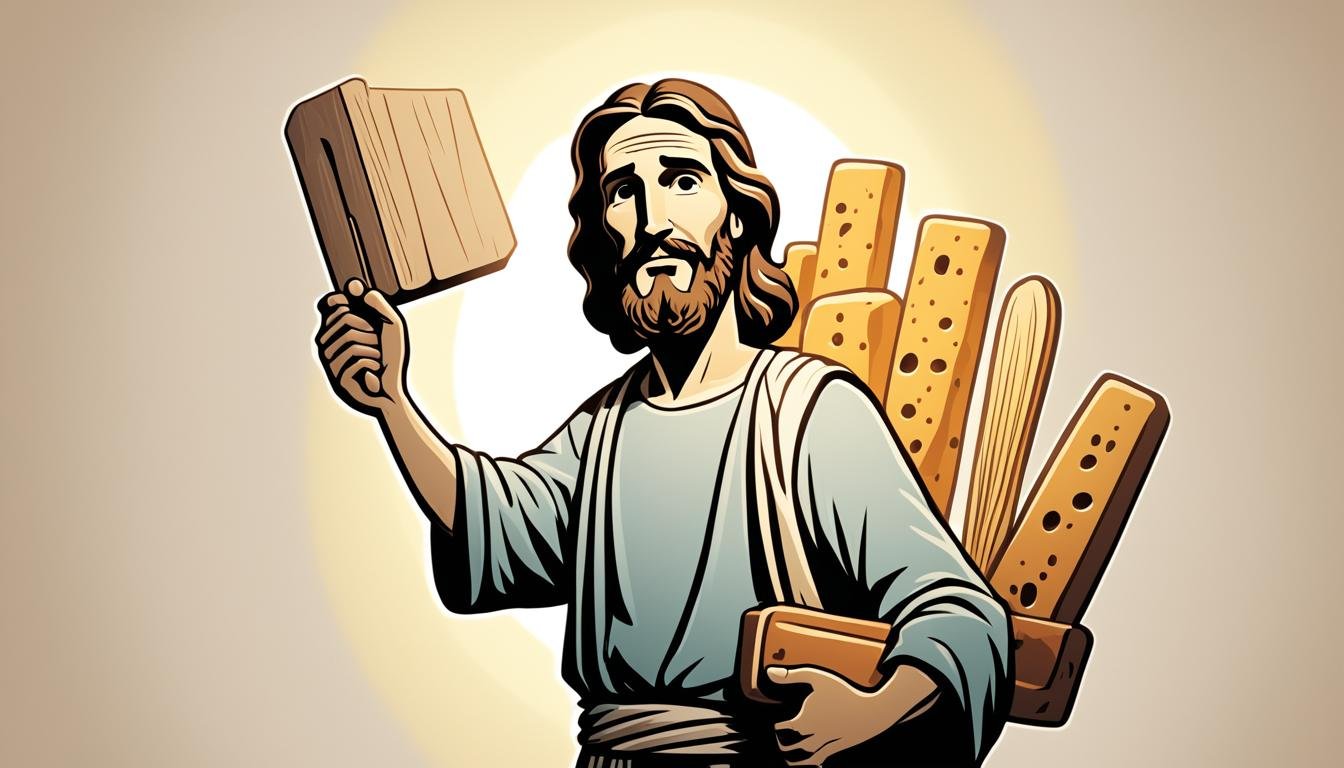The debate surrounding Jesus’ dominant hand, whether he was right or left-handed, has sparked intrigue and discussion among scholars and believers alike. This seemingly trivial question carries with it historical and cultural implications, offering insights into Jesus’ identity and the context of his teachings.
While the Bible does not provide a definitive answer to this question, it is worth exploring the topic by examining biblical texts and considering the cultural norms of Jesus’ time. By delving into these aspects, we can gain a deeper understanding of Jesus’ life and the significance of his actions.
Key Takeaways:
- The debate on whether Jesus was right or left-handed has historical and cultural implications.
- Examining biblical texts and cultural context can provide insight into this topic.
- Jesus’ teachings prioritize love, grace, and freedom over force and political rebellion.
- The Bible reflects a biased view against left-handedness, which is a product of cultural norms.
- Embracing the mystery of Jesus’ nature and identity can deepen our understanding of faith.
The Power of Christ’s Left-Handed Approach
In the gospels, Jesus is portrayed as a powerful figure who wielded a unique kind of power, often referred to as “left-handed power.” Unlike the conventional use of force and authority, Jesus emphasized love, grace, freedom, and the transformation of relationships.
Jesus’s approach to power challenged the societal norms of his time. Instead of seeking dominance or control, he focused on changing hearts and minds through acts of love, sacrifice, service, forgiveness, and mercy. By prioritizing these values, Jesus demonstrated the true power that lies in selflessness and compassion.
“Love one another. As I have loved you, so you must love one another.”
This left-handed approach differed greatly from the prevailing ideas of power during Jesus’s time. While others sought to overthrow the oppressive Roman rule or establish political dominance, Jesus taught his followers to seek freedom through love. His aim was not to conquer through force but to inspire transformation through loving relationships.
This approach is exemplified in Jesus’s interactions with individuals from all walks of life. He engaged with outcasts, welcomed sinners, and showed compassion towards the marginalized. By doing so, he shattered societal boundaries and expanded the understanding of love and grace.
The Parable of the Good Samaritan
A paragon of love is depicted in the Parable of the Good Samaritan. In this story, a man from a despised group, the Samaritans, goes out of his way to help a stranger who was beaten and left for dead. The Samaritan’s compassion and selfless act stood in stark contrast to the religious leaders who passed by without extending aid. Through this parable, Jesus illustrated the transformative power of love and challenged societal prejudices.
Jesus’s left-handed approach to power continues to inspire and captivate people today. It offers a profound perspective on leadership, relationships, and the potential for positive change in our communities. By following Jesus’s example, we can cultivate a power that transcends earthly measures and has the ability to heal, transform, and bring freedom to individuals and societies.
Indeed, the power of Christ’s left-handed approach lies in its ability to uplift, reconcile, and bring about true freedom. It reminds us of the potential we all have to make a difference in the lives of others through acts of love, grace, and selflessness.
| Benefits of Christ’s Left-Handed Power | Examples |
|---|---|
| Transformation of hearts and minds | The conversion of Saul, who became the apostle Paul, through an encounter with Christ’s love and grace. |
| Healing and reconciliation | The forgiveness extended by Jesus to those who crucified him, exemplifying the transformative power of forgiveness and reconciliation. |
| Building strong and loving communities | The early Christian communities that were formed on the basis of love, fellowship, and mutual care for one another. |
The power of Christ’s left-handed approach continues to resonate today, reminding us of the immense potential for positive change that lies within each of us. By embracing love, grace, and selflessness, we can bring healing, reconciliation, and freedom to our relationships and communities.
The Temptation of Jesus and Right-Handed Power
In the temptation of Jesus in the wilderness, he faced a pivotal moment where Satan offered him a chance to gain power through force. This temptation presented a direct challenge to Jesus’ purpose and mission on earth. However, Jesus firmly rejected this right-handed approach to power, choosing instead to manifest his power in a left-handed way through love and sacrificial acts.
“And the devil took him up and showed him all the kingdoms of the world in a moment of time, and said to him, ‘To you I will give all this authority and their glory, for it has been delivered to me, and I give it to whom I will. If you, then, will worship me, it will all be yours.’ And Jesus answered him, ‘It is written, “You shall worship the Lord your God, and him only shall you serve.”‘
This encounter with Satan revealed Jesus’ unwavering commitment to the left-handed power of love and grace. Instead of pursuing political rebellion and the forceful overthrow of oppressive systems, Jesus chose to establish his kingdom through acts of compassion, forgiveness, and self-sacrifice. By resisting the temptation of right-handed power, Jesus demonstrated his divine authority and the transformative potential of his left-handed approach.
The Power of Love Over Force
The temptation of Jesus highlights the contrast between the allure of right-handed power and the true power that Jesus embodies – the left-handed power of love. While force can impose temporary control and dominance, it often perpetuates cycles of violence and oppression. In contrast, love has the power to change hearts, restore relationships, and bring lasting transformation.
By rejecting the path of force, Jesus modeled a radical alternative – the power of love and sacrificial service. Throughout his ministry, he consistently demonstrated his power through healing the sick, feeding the hungry, forgiving sins, and ultimately sacrificing his own life on the cross. These acts of love and selflessness challenged societal norms and defied the expectations of a world governed by right-handed power.
Jesus’ choice to embrace left-handed power was not a sign of weakness or passivity, but rather a revolutionary act that combated the root causes of injustice and oppression. It subverted the status quo and challenged systems that valued dominance and control over compassion and equality.
Relevance Today
The temptation of Jesus and his subsequent rejection of right-handed power resonates with contemporary challenges and temptations. In a world plagued by political strife, social injustice, and the misuse of power, Jesus’ example serves as a guiding light, reminding us of the transformative potential of love, grace, and self-sacrifice.
Today, we are often tempted to use force to achieve our desired outcomes, whether it be in personal relationships, politics, or societal change. However, the temptation of Jesus reminds us that true power lies in the ability to love and serve others, rather than seeking dominance and control.
Embracing Jesus’ left-handed approach to power requires a paradigm shift in our thinking and actions. It compels us to prioritize compassion, forgiveness, and justice in our relationships and interactions with others. By following Jesus’ example, we can challenge oppressive systems and contribute to the establishment of a more equitable and loving society.
Jesus’ Teaching on Bread of Life and Left-Handed Power
In John 6, Jesus performs a miraculous feeding of the 5000, leaving the crowd in awe of his power. This event offers a profound insight into Jesus’ teaching on the bread of life and his rejection of the temptation to use his power for political gain.
The people who witnessed the miracle were ready to exalt Jesus as their political savior, someone who could overthrow the oppressive Roman rule. However, Jesus resists this temptation and redirects their focus towards the true meaning of his power.
“I am the bread of life,” Jesus declares. “Whoever comes to me will never go hungry, and whoever believes in me will never be thirsty” (John 6:35).
This statement emphasizes the spiritual sustenance that Jesus offers, going beyond physical nourishment. By proclaiming himself as the bread of life, Jesus introduces a left-handed approach to power, rooted in love, self-sacrifice, and spiritual transformation.
Through this teaching, Jesus reveals his mission and foreshadows his own death on the cross. The bread of life metaphor highlights Jesus’ willingness to sacrifice himself for the redemption of humanity, showcasing the left-handed power of love and selflessness.
This left-handed approach baffled many, as they expected a Messiah who would lead a political revolution. However, Jesus’ rejection of political power and his focus on spiritual transformation challenged the conventional understanding of power.
By emphasizing the bread of life and his own sacrificial death, Jesus invites his followers to embrace a new way of relating to power. This left-handed power rejects force, domination, and political agendas in favor of love, grace, and self-giving.
This teaching resonates with the wider message of Jesus’ ministry, which is filled with acts of compassion, miracles, and the proclamation of the kingdom of God. Each miracle performed by Jesus demonstrates the left-handed power of love, healing, and restoration, showcasing his divine authority and transforming lives.
Jesus’ rejection of the temptation to seize political power and his teaching on the bread of life reveal his commitment to a left-handed approach rooted in humility, love, and self-sacrifice. It challenges our cultural understanding of power and calls us to embrace a deeper and more transformative understanding of what it means to follow Jesus.
| Key Points | Implications |
|---|---|
| Jesus’ teaching on the bread of life | Emphasizes spiritual sustenance and sacrificial love. |
| Rejection of political power | Challenges societal expectations and reveals a left-handed approach. |
| Miracles and acts of compassion | Showcase the left-handed power of love and divine authority. |
In the next section, we will explore the contrasting views of power held by Jesus and his disciples, further highlighting the left-handed approach to power advocated by Jesus.
Contrasting Views of Power – Jesus and the Disciples
In Mark 9, the disciples held a perspective on power that aligned with traditional right-handed power dynamics and the establishment of an earthly kingdom. However, Jesus challenged and contrasted their view by using a powerful teaching method that revealed the true essence of power.
Jesus chose to place a child before the disciples, symbolizing the unlovable and the servants among them. By doing so, Jesus emphasized that true power is not found in dominating others or seeking positions of authority. Instead, it is found in serving and loving those who society often overlooks.
This powerful demonstration highlighted the disparity between the world’s understanding of power and Jesus’ revolutionary approach. While the disciples aspired to positions of influence and the establishment of an earthly kingdom, Jesus refocused their attention on the importance of humility, love, and selflessness.
“Whoever wants to be first must be the very last and the servant of all.”
| Disciples’ View of Power | Jesus’ View of Power |
|---|---|
| Political influence and authority | Serving and loving others |
| Establishment of an earthly kingdom | Highlighting the Kingdom of God |
| Desire for recognition and status | Focusing on humility and selflessness |
This stark contrast between the disciples’ perspective on power and Jesus’ teaching serves as a timeless reminder that true power lies not in the exertion of authority, but in the willingness to serve others sacrificially.

Embracing the Power of Serving Others
Jesus’ example challenges us to reevaluate our own understanding of power. In a world driven by ambition and self-promotion, we are called to emulate Jesus’ left-handed approach by embracing the power of serving others.
- Recognize the inherent worth of everyone around us, including those society marginalizes.
- Practice acts of love, kindness, and selflessness towards those who may be considered unlovable or insignificant.
- Use our influence and resources to uplift and empower those who are oppressed or disadvantaged.
- Seek opportunities to serve and meet the needs of others, even in humble and unnoticed ways.
- Let go of the desire for recognition and instead find fulfillment in the transformative impact of serving others.
By embracing Jesus’ left-handed approach to power, we can contribute to the building of a more compassionate and just society, where the well-being of others takes precedence over personal gain and status.
Paul’s Understanding of Power and Weakness
In 2 Corinthians 12:9, Paul offers profound insights into the power of weakness and the importance of dependence on God. He emphasizes that true power does not lie in human strength or accomplishments, but rather in surrendering our own power and relying on God’s grace. Paul recognizes the inherent limitations and vulnerabilities of human nature, and he reveals the transformative strength that emerges from embracing our weaknesses and acknowledging our need for God.
“But he said to me, ‘My grace is sufficient for you, for my power is made perfect in weakness.’ Therefore I will boast all the more gladly about my weaknesses, so that Christ’s power may rest on me.”
This powerful statement emphasizes the paradoxical nature of power and weakness, illustrating that true strength is found in our dependence on God rather than our own abilities. Paul’s understanding aligns perfectly with Jesus’ teachings of love, sacrifice, and humility, which prioritize the care for others and the recognition that we are not self-sufficient beings. By acknowledging our weaknesses and embracing our dependence on God, we tap into the divine power that enables us to navigate life’s challenges with grace and resilience.
The Power of Weakness: Lessons from Paul
Paul’s teachings highlight several essential lessons about the power of weakness:
- Humility: Recognizing our weaknesses cultivates humility, allowing us to approach life with openness and a willingness to learn from others. It shifts our focus from self-centeredness to a greater awareness of our interconnectedness as members of God’s creation.
- Reliance on God: Embracing our weaknesses highlights our need for God’s guidance, strength, and provision. It reminds us that we are not meant to face life’s challenges alone but rather to trust in God’s infinite wisdom and love.
- Growth: Our weaknesses become opportunities for growth and transformation, as we lean on God’s grace to overcome obstacles. Through our surrender and dependence on God, our weaknesses can be transformed into sources of strength and resilience.
An Inspiring Example: Paul’s Life
Paul’s life serves as a powerful testament to the strength and transformative power that comes through embracing weakness. Despite facing numerous trials, persecutions, and hardships, Paul persevered in his faith and ministry through the power of God’s grace. His willingness to surrender his own power and rely on God enabled him to spread the message of Christ and leave a lasting impact on the early Christian community.
This image showcases the theme of the power of weakness, symbolizing how embracing our weaknesses can lead to personal growth and reliance on God. It serves as a visual reminder that the path to true power is found in surrender and dependence on God’s grace.
A Table: Paul’s Journey of Weakness and Power
| Moments of Weakness | Manifestations of Divine Power |
|---|---|
| Persecution and imprisonment | Paul’s unwavering faith and ability to spread the gospel even in chains |
| Thorn in the flesh | God’s grace sustaining Paul and enabling him to endure hardships |
| Moments of doubt and despair | Divine reassurance and guidance, strengthening Paul’s resolve |
| Human limitations and weaknesses | God’s power working through Paul to perform miracles and lead others to Christ |
This table highlights key moments in Paul’s journey where his weaknesses intersected with and were transformed by divine power. It showcases the inherent connection between weakness and the manifestation of God’s strength, reminding us of the transformative potential found in surrender and reliance on God.
Debunking the Left-Handed Stigma
The Bible reflects a biased view against left-handedness, associating it with treachery and being unnatural. However, this bias is a product of cultural norms and not a reflection of any inherent evil or inferiority in being left-handed.
Throughout history, left-handed individuals have faced misconceptions and unfair judgments due to societal prejudices. In many cultures, including biblical times, right-handedness was considered superior and left-handedness was often associated with negative connotations.
One example of this biblical bias can be seen in the Book of Judges, where Ehud, a left-handed man, is depicted as an assassin. The narrative highlights his left-handedness as a secretive and deceptive trait, perpetuating the belief that being left-handed is associated with dishonesty or treachery.
However, it is important to note that biblical texts should be interpreted within their historical and cultural contexts. The bias against left-handedness found in these texts is not a divine judgment but rather reflects the prevailing cultural attitudes and beliefs of the time.
In reality, left-handedness is a natural variation in human physiology, not a flaw or moral failing. Left-handed individuals possess unique strengths and abilities, just like their right-handed counterparts. Numerous famous left-handed individuals throughout history have contributed immensely to various fields, such as Leonardo da Vinci, Albert Einstein, and Oprah Winfrey.
“Left-handedness represents a different way of navigating the world, not a deficiency. It is important to challenge the misconceptions and unfair judgments associated with left-handedness.”
By debunking the left-handed stigma and challenging the biased perceptions, society can foster inclusivity and celebrate the diversity of human experiences. Embracing and accepting left-handed individuals for who they are can create a more equitable and understanding world.
To further debunk the misconceptions surrounding left-handedness, let us take a closer look at a comparative table highlighting some of the common myths and the corresponding realities:
| Myths about Left-Handedness | Realities of Left-Handedness |
|---|---|
| Left-handedness is unnatural | Left-handedness is a natural variation in human physiology |
| Left-handed individuals are less intelligent | Left-handed individuals possess the same intellectual capabilities as right-handed individuals |
| Left-handed individuals are more prone to accidents | Accident-proneness is not determined by left-handedness |
| Left-handedness can be “corrected” | Left-handedness should be embraced and supported rather than corrected |
It is crucial to dispel these misconceptions and recognize the worth and value of left-handed individuals. By fostering a more inclusive and accepting environment, we can celebrate the uniqueness and diversity of our human family.

Additional Resources:
- Left-Handers Day: Celebrating Left-Handedness
- Left-Handed Myths and Facts
- Facts About Left-Handedness
DNA and Jesus’ Pre-Incarnate Existence
If one holds the belief in a pre-incarnate existence for Jesus, it raises questions about Jesus’ ability to choose his DNA before being born. This concept becomes more complicated when considering the implications of genetic predispositions and Jesus’ understanding of human struggles and temptations.
The idea of Jesus choosing his DNA before his birth brings forth intriguing implications. Was he aware of the genetic predispositions that would influence his human experience? Did Jesus purposefully select a genetic makeup that would allow him to relate to the struggles and temptations of humanity?”
Understanding Jesus’ pre-incarnate existence and its connection to DNA involves exploring the depth of his divine knowledge and the extent of his human experience. The mystery lies in reconciling his omniscience with his experience of vulnerability and human limitations.
While the scriptures offer minimal insight into the specifics of Jesus’ pre-incarnate existence, Christians can engage in theological reflection on this topic. It paves the way for contemplation, drawing attention to the profound unity of the divine and human in Jesus.
Considering the DNA implications, one might ponder the significance of genetic predispositions in shaping human behavior, emotions, and physical attributes. Did Jesus willingly embrace these inherent traits to better empathize with and understand humanity?
Expanding further, Jesus’ choice to take on DNA through the incarnation reveals a divine intention to fully enter into the human condition. It demonstrates an intentional identification with humanity’s struggles, including the profound impact of genetics on individual lives.
The Limitations of Jesus’ Human Nature
The concept of Jesus being both fully God and fully human presents intriguing challenges and raises thought-provoking questions. At the heart of this theological mystery is the idea of Jesus possessing divine abilities while existing in human form. Such a paradox naturally leads to inquiries about the extent of Jesus’ divine attributes and the limitations imposed by his humanity.
One of the primary concerns that arise in understanding Jesus’ dual nature is the logical contradictions it presents. How can someone be 100% God and 100% man simultaneously without encountering inherent contradictions? This philosophical dilemma leaves room for introspection and contemplation.
Questions inevitably emerge regarding Jesus’ knowledge and awareness. As a human being experiencing life in its fullest, did Jesus possess complete omniscience as the divine Son of God? Did he have divine knowledge of all things past, present, and future? Or did his human nature impose limitations on his understanding, causing him to rely on revelation and learning from his surroundings?
The issue of Jesus’ abilities is also a topic of great intrigue. While his divine nature suggests the existence of limitless power, his human form begs the question of how this power was manifested. Did Jesus perform miracles and exhibit divine abilities by tapping into his innate divinity? Or did he rely solely on the power of the Holy Spirit, emphasizing his dependence on God rather than asserting his own divine prowess?
Exploring the limitations of Jesus’ human nature leads us into the realm of theological mystery and invites us to embrace the beauty of divine paradox. While we may not find definitive answers to these perplexing questions, it is the acceptance of the mystery that deepens our faith and strengthens our spiritual journey.
Jesus’ Human Nature vs. Divine Attributes
| Human Nature | Divine Attributes |
|---|---|
| Subject to human limitations | Eternal and infinite |
| Experiences human emotions | Perfect love and mercy |
| Requires rest and sustenance | Self-sufficient and sustaining |
| Has limited knowledge | Omniscient and all-knowing |
| Experiences physical suffering and death | Conquers death and offers eternal life |

“God became human so that humanity could become divine.” – Saint Athanasius
The Mystery of Jesus’ Nature
Instead of seeking definitive answers to the intricacies of Jesus’ nature and the union of his humanity and divinity, it may be more appropriate to embrace the mystery. The complexity of Jesus’ nature goes beyond human comprehension, and accepting this mystery is a testament to our faith.
Jesus, both fully human and fully divine, presents a profound paradox that challenges our limited human understanding. While we may desire clear-cut explanations and logical reasoning, the nature of Jesus transcends our intellectual capacity. It is in accepting the limitations of our human understanding and embracing the mystery that we can truly encounter the depths of Jesus’ divine nature.
This acceptance of mystery underscores the dynamics of faith. Faith requires us to trust in what we cannot fully grasp or comprehend. It calls us to surrender the need for complete understanding and instead rely on a willingness to believe in what is beyond our immediate comprehension.
“Now faith is the assurance of things hoped for, the conviction of things not seen.” – Hebrews 11:1
In navigating the complexities of Jesus’ dual nature, we are reminded that our encounter with the divine is not confined to the boundaries of human logic. It is through faith that we can engage with the divine mysteries that surpass our understanding.
The mystery of Jesus’ nature invites us to approach his teachings, miracles, and interactions with humility and awe. Rather than trying to fit Jesus into a neat, comprehensible box, we are called to dwell in the wonder and mystery of his divinity and humanity coexisting in perfect harmony.
While theological discussions and debates continue to explore the intricacies of Jesus’ nature, it is important to recognize the inherent limitations of our human perspectives. Just as a drop of water cannot comprehend the vastness of the ocean, our finite minds cannot fully grasp the infinite nature of Jesus.
Embracing the mystery of Jesus’ nature entails a willingness to let go of our intellectual pride and open ourselves to the beauty of the divine paradox. It is in this acceptance that we can truly encounter the transformative power of the One who is both fully human and fully divine.
Conclusion
The debate surrounding whether Jesus was right or left-handed invites us to delve into the profound complexities of his human-divine nature. While definitive answers may elude us, the exploration of these questions opens doors to a deeper understanding of our faith and an embrace of the mystery that surrounds Jesus’ identity.
As we contemplate Jesus’ nature, we recognize that he transcended conventional notions of power. In his teachings and actions, Jesus exemplified a left-handed approach, emphasizing love, grace, and freedom over force and political rebellion. His profound impact on humanity stemmed from acts of sacrificial love, service, forgiveness, and mercy.
Throughout his ministry, Jesus consistently rejected the allure of right-handed power, as demonstrated in the temptations he faced. Instead of succumbing to worldly ambitions, he remained committed to manifesting his power through love and sacrificial acts, forging a path that challenged prevailing cultural norms.
While we may be drawn to unravel the mysteries surrounding Jesus’ human-divine nature, it is essential to acknowledge that our understanding is imperfect and limited. Embracing the mystery becomes an act of faith, recognizing that we cannot fully comprehend the profound union of Jesus’ humanity and divinity. Our journey of faith invites us to accept the unexplainable and humbly embrace the unknown as we seek to follow in the footsteps of Jesus.
FAQ
Was Jesus right or left-handed?
There is no definitive answer to this question. The debate on whether Jesus was right or left-handed has historical and cultural implications. Examining biblical texts and cultural context can provide insight into this topic.
What was the power of Christ’s left-handed approach?
The power of Christ’s left-handed approach emphasized love, grace, and freedom. Jesus prioritized changing hearts through acts of love, sacrifice, service, forgiveness, and mercy rather than launching a political rebellion or overthrowing Rome.
How did Jesus reject right-handed power in the temptation?
In the temptation of Jesus in the wilderness, Satan offers Jesus a chance to gain power through force. However, Jesus rejects this right-handed approach to power, choosing instead to manifest his power in a left-handed way through love and sacrificial acts.
What did Jesus teach about the bread of life and left-handed power?
In John 6, when Jesus feeds the 5000, the people are ready for him to use his power for political purposes. However, Jesus rejects this temptation and emphasizes that he is the bread of life, previewing his own death and emphasizing the left-handed approach of love and sacrifice.
How did Jesus contrast the disciples’ view of power?
In Mark 9, the disciples have a view of power that aligns with right-handed power and the establishment of an earthly kingdom. However, Jesus contrasts their view by placing a child before them, teaching that true power is found in loving, embracing, and serving the unlovable and the servants among them.
What was Paul’s understanding of power and weakness?
Paul, in 2 Corinthians 12:9, acknowledges the power of weakness and the strength that comes from dependence on God. He recognizes that true power is not in human strength but in surrendering one’s own power and relying on God’s grace.
Is there a bias against left-handedness in the Bible?
Yes, the Bible reflects a biased view against left-handedness, associating it with treachery and being unnatural. However, this bias is a product of cultural norms and not a reflection of any inherent evil or inferiority in being left-handed.
What are the implications of Jesus’ pre-incarnate existence on his DNA?
If one holds the belief in a pre-incarnate existence for Jesus, it raises questions about Jesus’ ability to choose his DNA before being born. This concept becomes more complicated when considering the implications of genetic predispositions and Jesus’ understanding of human struggles and temptations.
What are the challenges of Jesus’ nature as fully God and fully human?
The concept of Jesus being both fully God and fully human presents challenges, including the idea of Jesus utilizing divine powers while in human form. Questions arise about Jesus’ knowledge, abilities, and limitations as a human being who also possesses divine attributes.
Should we seek definitive answers or embrace the mystery of Jesus’ nature?
Instead of seeking definitive answers to the intricacies of Jesus’ nature and the union of his humanity and divinity, it may be more appropriate to embrace the mystery. The complexity of Jesus’ nature goes beyond human comprehension, and accepting this mystery is a testament to our faith.
What can the debate over Jesus’ right or left-handedness teach us?
The debate over whether Jesus was right or left-handed offers an opportunity to reflect on the intricacies of Jesus’ human-divine nature. While we may not have clear answers, exploring these questions can deepen our understanding of faith and our acceptance of the mystery surrounding Jesus’ identity.
Source Links
- https://gbcbowie.org/blog/jesus-is-not-right-handed/
- https://www.daily-prayers.org/fr-johns-weekly/was-jesus-right-or-left-handed/
- https://www.debunking-christianity.com/2006/08/was-jesus-left-handed.html

I’m Benjamin, a passionate spiritual seeker and creator of Verses and Prayers. Alongside my girlfriend Emma and our pet lizard Mulle, I cherish family life, enjoy exploring new places, and am deeply involved in my church community. My love for reading and singing biblical verses inspires every aspect of my journey.

